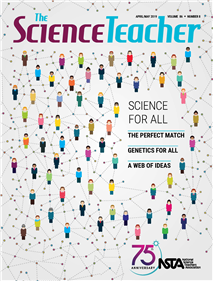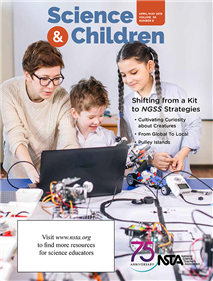All Resources
Journal Article
Journal Article
Understanding students, adapting instruction, and addressing equity ...
By Kelsie Fowler, Mark Windschitl, and Jennifer Richards
Journal Article
Mobile geospatial technologies enable high school students to engage in authentic scientific data collection and analysis that promote spatial-thinking and reasoning skills, as well as problem-solving in a school’s local environment. We developed a...
By James Carrigan, Alec Bodzin, Thomas Hammond, Scott Rutzmoser, Kate Popejoy, and William Farina
Journal Article
A lesson that focuses on the intricate co-evolution of flowers with their pollinators is one way to help students learn the delicate balance in nature and help ensure that our actions do not upset this balance. In this lesson students use the enginee...
By Julie Reynolds
Journal Article
This paper highlights learning supports associated with genetics lessons that were implemented in a urban high school biology classroom. The supports provided access to science content for ELs, students with IEPs, and struggling readers during an int...
By Lauren Stewart, Donna Ross, and Kimberly Elliot
Journal Article
Fostering scientific discourse with spider web discussions ...
By Michael Giamellaro, Jackson Blackburn, Molly Honea, and Jacob LaPlante
Journal Article
Exploring light as it moves from one medium to another with the intriguing result of different speeds—the bending of light we call refraction. ...
By Paul G. Hewitt
Journal Article
Ecologists are biologists who study entire ecosystems and the interactions among their living and non-living components. Ecology can be applied in areas such as conservation biology, natural resource management, and even economics. Todd Elliott, who ...
By Luba Vangelova
Journal Article
Science for All—19th Century "Edutainment"
In 19th-century America, one popular way people obtained new scientific information was through traveling lectures and science demonstrations, sometimes held in large halls called “lyceums.” Before the advent of radio and television, these were l...
By Michael Apfeldorf
Journal Article
This column discusses resources and science topics related to students in grades preK to 2. This issue describes how teachers can build their own kits....
Journal Article
Animatronic Lions, and Tigers, and Bears Oh! My!
This column describes creating a classroom culture for engineering. This issue shares information about computational thinking and 3D printing. ...
By Anna Newley, Erdogan Kaya, Ezgi Yesilyurt, and Hasan Deniz
Journal Article
Making Critical Thinking Visible for Student Analysis and Reflection
Practice critical-thinking skills with this phenomena-centered dinosaur bone activity. ...
By Kirsten R. Butcher, Madlyn Larson, McKenna Lane
Journal Article
Sharing the Wonder of Natural History
Help students overcome nature-deficit disorder with these outdoor activities. ...
By Ashley Campbell, Brigette Whaley
Journal Article
Investigating the Resurrection Plant
Using discrepant events to confront misconceptions. ...
By Todd Hoover
Journal Article
Observing Environmental Changes from Earth's Orbit
Astronomy throughout the year. ...
By Bob Riddle
Journal Article
Speaking and Listening in the Science Classroom
Practical advice from veteran teachers. ...
By Kathy Biernat, Laura Riley
Journal Article
Evolving Students' Writing Skills
Strategies for increasing student engagement. ...
By Kaitlyn McGlynn, Janey Kelly
Journal Article
Hardware, software, and websites for use in the classroom. ...
By Kiley McElroy-Brown, Frieda Reichsman
Journal Article
By Kylie S. Hoyle, Kristie S. Gutierrez, Lauren A. Harper, Brandon D. Hollingsworth, Margaret R. Blanchard





